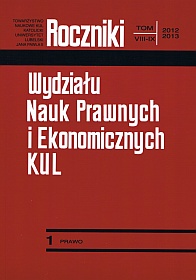Definitions and Conditioning of Illegal Immigration
Abstract
One of the distinctive features of the society development, mainly European society, is a spatial mobility. the phenomenon known as human migration is usually connected with the search for better, more often safer place for ourselves and our relatives. Migration, especially nowadays, in many cases is illegal and contrary to international and national law. the illegal form of migration of a human being is conditioned by disproportion between the migrants' origin countries and their target countries. the article presents both the causes and conditions of illegal migration, which are strictly linked. A crucial element in defining the phenomenon of illegal immigration presented in the article is to connect this human migration as one of the form of crime that occurs wherever there are borders. Finding the root of illegal migration, the author presents separate research methods, moreover, tries to estimate the scale and presents direct relation between control system and elimination of this phenomenon.
References
Adamczyk M., Europejska Agencja Zarządzania Współpracą Operacyjną na Granicach Zewnętrznych Państw Członkowskich Unii Europejskiej, Warszawa: Centrum Europejskie-Natolin 2005, Materiały Robocze 1/05, s. 6.
Aglietta M., Borgy V., Chateau J., Juillard M., Le Cacheux J., Le Garrec G., Touze V., Scenarios for Global Ageing. An Investigation with the INGENUE 2 World Model, „ENERPRI Research Report” July 2005, No. 9, s. 27.
Anioł W., Migracje międzynarodowe a bezpieczeństwo europejskie, Warszawa: Instytut Studiów Politycznych Polskiej Akademii Nauk 1992.
Chateau J., Juillard M., Le Cacheux J., Le Garrec G., Touze V., Scenarios for Global Ageing. An Investigation with the INGENUE 2 World Model, „ENERPRI Research Report” July 2005, No. 9, s. 27.
Clarke J., the Problems of Evaluating Numbers of Illegal Immigrants in the European Union, w: Regularisations of Illegal Immigrants in the European Union, under the Supervision of Ph De, Brussels: Bruycker 2000.
Cywiński P., Go West, „Wprost” 1998, nr 47, s. 86.
Delauney D., Tapinos G., La mesure de la migration clandestine en Europe, Luxemburg: Eurostat Population and Social Conditions Working Paper, Vol. 3, No. 7, 1998.
Engelen E., Migration and the Contemporary Welfare State, w: World Migration 2005, s. 321.
Erdemir A., Vasta E., Differentiating Irregularity and Solidarity: Turkish Immigrants at Work in London, Centre on Migration, Oxford: Policy and Society 2007, Working Paper, No. 42, s. 8.
Fajgielski P., Przetwarzanie i ochrona danych osobowych w Systemie Informacyjnym Schengen, w: Układ z Schengen – szanse i zagrożenia współpracy transgranicznej, s. 63.
Głąbicka K., Przerzut migrantów jako nowa forma międzynarodowych wędrówek ludności w Polsce, w: K. Głąbicka, T. Halik, A. Sawicka (red.), Studia nad przerzutem migrantów, Warszawa: Instytut Studiów Społecznych Uniwersytetu Warszawskiego 1999, s. 7-11, Prace Migracyjne, nr 23.
Iglicka K., Nielegalna imigracja w Europie. Problemy, dane, techniki oraz wcześniejsze próby stworzenia porównawczej bazy danych lub szacunkowych danych (wprowadzenie do projektu „Clandestino” – mps).
Laczko F., Klekowski von Koppenfels A., Barthel J., Trafficking in Women from Central and Eastern Europe: A Review of Statistical Data, in New Challenges for Migration Policy in Central and Eastern Europe, red. F. Laczko, I. Stacher, A. Klekowski von Koppenfels, the Hague: Asser Press 2002, s. 153.
Papademetriou D., the Global Struggle with Illegal Migration: No End in Sight, September, 2005.
Salt J., Stein S., Migration as a Business: the Case of Trafficking, „International Migration” (Warszawa) 35 (1997), nr 4, s. 467.
Sakowicz A., Nielegalna imigracja na obszarze Unii Europejskiej a prawo karne, w: Zwalczanie przestępczości w Unii Europejskiej. Współpraca sądowa i policyjna w sprawach karnych, red. A. Górski, A. Sakowicz, Warszawa 2006.
Szachoń A., FRONTEX – praktyczna realizacja zasad dorobku prawnego Schengen w zakresie kontroli i ochrony zewnętrznych granic w UE, w: Układ z Schengen. Szanse i zagrożenia dla transgranicznej współpracy Polski i Ukrainy, red. A. Kuś, T. Sieniow, Lublin: Wydawnictwo KUL 2007.
Widmański L., System Informacyjny Schengen – podstawowy instrument funkcjonowania strefy Schengen, http://www.edukacjaprawnicza.pl/index.php?mod=m_aktualności&cid=69&id =655&p=1 (dostęp: 26 kwietnia 2011).
Zamojski J.E., Migracje doby współczesnej: geneza, charakterystyka, wyzwania i odpowiedzi, „Biuletyn Komitetu Przestrzennego Zagospodarowania Kraju” (Warszawa) 1998, z. 184.
Copyright (c) 2013 Roczniki Wydziału Nauk Prawnych i Ekonomicznych KUL

This work is licensed under a Creative Commons Attribution-NonCommercial-NoDerivatives 4.0 International License.

